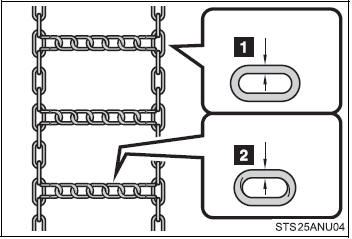 Toyota Yaris: Winter driving tips
Toyota Yaris: Winter driving tips
Carry out the necessary preparations and inspections before driving the vehicle in winter. Always drive the vehicle in a manner appropriate to the prevailing weather conditions.
■ Pre-winter preparations
● Use fluids that are appropriate to the prevailing outside temperatures.
• Engine oil
• Engine coolant
• Washer fluid
● Have a service technician inspect the level and specific gravity of battery
electrolyte.
● Have the vehicle fitted with four snow tires or purchase a set of tire chains
for the front tires.
Ensure that all tires are the same size and brand and that their wear level is not noticeably different with each other. Also make sure that chains match the size of the tires.
■ Before driving the vehicle
Perform the following according to the driving conditions:
● Do not try to forcibly open a window or move a wiper that is frozen. Pour warm
water over the frozen area to melt the ice. Wipe away the water immediately to prevent
it from freezing.
● To ensure proper operation of the climate control system fan, remove any snow
that has accumulated on the air inlet vents in front of the windshield.
● Remove any ice that has accumulated on the vehicle chassis.
● Periodically check for and remove any excess ice or snow that may have accumulated
in the wheel well or on the brakes.
■ When driving the vehicle
Accelerate the vehicle slowly and drive at a reduced speed suitable to the road conditions.
■ When parking the vehicle (in the winter time or in the cold latitudes)
Park the vehicle and move the shift lever to P (vehicles with an automatic transmission) or 1 or R (vehicles with a manual transmission) without setting the parking brake. The parking brake may freeze up, preventing it from being released. If necessary, block the wheels to prevent inadvertent sliding or creeping.
Selecting tire chains
Use the correct tire chain size when mounting the tire chains. Chain size is regulated for each tire size.

 Side chain
Side chain
3 mm (0.12 in.) in diameter
 Cross chain
Cross chain
4 mm (0.16 in.) in diameter
Regulations on the use of tire chains
Regulations regarding the use of tire chains vary depending on location and type of road. Always check local regulations before installing chains.
■Tire chain installation
Observe the following precautions when installing and removing chains:
●Install and remove tire chains in a safe location.
●Install tire chains on the front tires only. Do not install tire chains on the
rear tires.
●Install tire chains on front tires as tightly as possible. Retighten chains after
driving 1/4 - 1/2 mile (0.5 - 1.0 km).
●Install tire chains following the instructions provided with the tire chains.
●If wheel ornaments are used, they will be scratched by the chain band, so remove
the ornaments before putting on the chains. (→P. 317)
CAUTION
■Driving with snow tires
Observe the following precautions to reduce the risk of accidents. Failure to do so may result in a loss of vehicle control and cause death or serious injury.
●Use tires of the size specified.
●Maintain the recommended level of air pressure.
●Do not drive in excess of 75 mph (120 km/h), regardless of the type of snow tires
being used.
●Use snow tires on all, not just some wheels.
●Do not use tires of noticeably different wear level.
CAUTION
■Driving with tire chains
Observe the following precautions to reduce the risk of accidents. Failure to do so may result in the vehicle being unable to be driven safely, and may cause death or serious injury.
●Do not drive in excess of the speed limit specified for the tire chains being
used, or 30 mph (50 km/h), whichever is lower.
●Avoid driving on bumpy road surfaces or over potholes.
●Avoid sudden turns and braking, as use of chains may adversely affect vehicle handling.
●Slow down sufficiently before entering a curve to ensure that vehicle control is
maintained.
NOTICE
■Repairing or replacing snow tires (vehicles with a tire pressure warning system)
Request repairs or replacement of snow tires from Toyota dealers or legitimate tire retailers. This is because the removal and attachment of snow tires affects the operation of the tire pressure warning valves and transmitters.
■Fitting tire chains (vehicles with a tire pressure warning system)
The tire pressure warning valves and transmitters may not function correctly when tire chains are fitted.
 Vehicle load limits
Vehicle load limits
Vehicle load limits include total load capacity, seating capacity, towing
capacity and cargo capacity.
■ Total load capacity (vehicle capacity weight): (→P. 342)
Total load capacity me ...
 Trailer towing (except 3-door models for Canada)
Trailer towing (except 3-door models for Canada)
Toyota does not recommend towing a trailer with your vehicle. Toyota also
does not recommend the installation of a tow hitch or the use of a tow hitch carrier
for a wheelchair, scooter, bicycle, e ...
See also:
Ignition switch
“START”—Starter motor on. The key will return to the “ON” position when released.
For starting tips, see Section 3.
“ON”—Engine on and all accessories on.
This is the normal d ...
If you lose your keys
New genuine Toyota keys can be made by your Toyota dealer using the other
key and the key number stamped on your key number plate. ...
Foamed material application areas
The sections shown in the figure below are filled with foamed material to provide
noise insulation.
Refill with foamed materials after repairing these sections and their surrounding
sections.
HI ...
